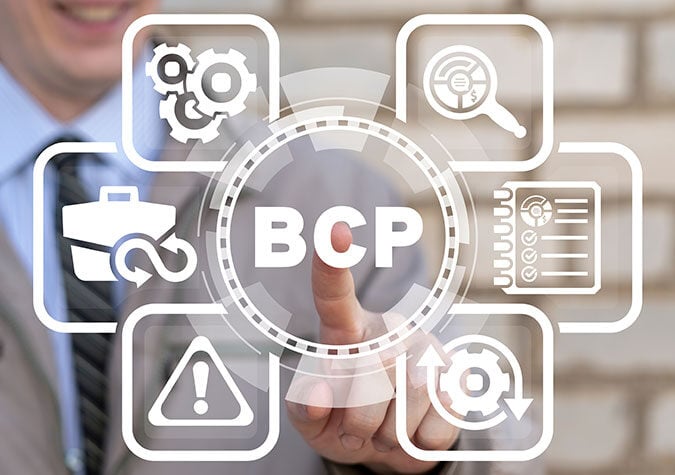Optimize Your Supply Chain with Strategic Business Continuity Planning
The Critical Role of Business Continuity Planning in Supply Chain Optimization
In an increasingly volatile global marketplace, business continuity planning (BCP) is no longer a luxury—it’s a critical component of supply chain optimization.
Effective BCP ensures that supply chain disruptions don't derail your operations, allowing your business to maintain service delivery, customer satisfaction, and competitive advantage. As new challenges arise, from natural disasters to cyber threats, BCP is integral to creating a resilient and optimized supply chain.
Furthermore, the adoption of emerging technologies can revolutionize your continuity strategies, creating new layers of protection and efficiency.


What is Business Continuity Planning?
Business continuity planning involves establishing protocols to prepare for and respond to disruptions.
For supply chain management, this means ensuring that essential logistics, production, and distribution activities can continue, even in the face of significant interruptions.
A solid BCP outlines emergency response actions, communication strategies, resource allocation, and recovery steps, helping businesses optimize their supply chains for long-term resilience and efficiency.
Why Business Continuity is Crucial for Supply Chain Optimization
A robust business continuity plan is essential for optimizing your supply chain:
- Risk Mitigation and Optimization: By minimizing the impact of disruptions, you can maintain operational efficiency and keep your supply chain running smoothly. This helps avoid costly delays, missed opportunities, and lost revenue, leading to a more optimized supply chain.
- Resilience Building: A well-structured BCP enhances the resilience of your supply chain, allowing you to recover quickly from unexpected events while sustaining critical operations.
- Technology Integration: Leveraging emerging technologies such as AI, IoT, and blockchain can strengthen business continuity planning, allowing for real-time monitoring, predictive analytics, and automated response systems that further optimize your supply chain.
- Compliance and Competitive Advantage: Many industries now mandate BCP as part of regulatory requirements. Meeting these standards helps avoid penalties and strengthens your market position by demonstrating preparedness.

How Emerging Technology Impacts Business Continuity
The rapid advancement of emerging technologies like artificial intelligence (AI), blockchain, and the Internet of Things (IoT) is transforming supply chain continuity and optimization. These technologies enhance visibility, enable predictive analytics, and support proactive risk management:
AI & Machine Learning
Blockchain Technology
Blockchain ensures transparency and security in transactions, helping trace goods throughout the supply chain and quickly identify points of failure during disruptions.
IoT Devices
IoT sensors provide real-time data on inventory levels, environmental conditions, and equipment performance, enabling businesses to detect and address issues before they escalate into major disruptions.
Incorporating these technologies into your BCP not only strengthens your resilience but also optimizes your supply chain for greater agility and efficiency.
Key steps and strategies
How to Create Supply Chain Resilience and Avoid Disruption
- Diversify Your Supply Base: Reduce dependency on a single supplier by establishing relationships with multiple suppliers across different regions. This diversification spreads risk and helps maintain operations even if one supplier encounters issues.
- Enhance Flexibility: Implement flexible logistics networks and agile production systems that can quickly adapt to changing conditions. This flexibility allows your supply chain to pivot as needed, responding effectively to unexpected challenges.
- Optimize Inventory Management: Utilize advanced forecasting tools to maintain balanced inventory levels, avoiding both shortages and overstock. Effective inventory management ensures you're prepared for potential disruptions without excessive capital tied up in stock.
- Conduct Ongoing Risk Assessment and Monitoring: Leverage real-time data and predictive analytics to continuously assess and monitor risks within your supply chain. Early detection through these tools enables timely mitigation of potential issues, keeping your operations running smoothly.
- Practice Scenario Planning and Testing: Regularly run scenario planning exercises and simulations to test the effectiveness of your supply chain’s continuity strategies. These practices prepare your team to handle a wide range of disruptions, ensuring a robust response when needed.
- Build a Comprehensive Business Continuity Plan: To further fortify your supply chain, develop a detailed business continuity plan. Start with a thorough Risk Assessment to identify all potential threats—ranging from natural disasters to cyber threats and supplier failures. Follow this with a Business Impact Analysis (BIA) to pinpoint critical supply chain activities, understand dependencies, and assess the financial and operational impacts of disruptions.
- Next, Develop Continuity Strategies that include emergency procedures, crisis communication protocols, resource reallocation strategies, and recovery timelines. These strategies should be actionable and clear, guiding your team through any disruption.
- Integrate Advanced Technologies: Adopt emerging technologies such as AI, IoT, and blockchain to strengthen your supply chain’s resilience. AI can automate responses to specific disruptions, while IoT sensors provide real-time visibility into your operations, enabling quick adjustments as needed.
- Train and Conduct Drills: Regular training and drills are crucial to ensuring that your employees are familiar with the continuity plan and can execute it effectively in the event of a disruption. These exercises build confidence and ensure preparedness across your organization.
By following these steps, you can build a resilient supply chain that not only withstands disruptions but also ensures continuous, efficient operations in the face of adversity.

Who should Be involved in business continuity planning?
Developing a business continuity plan for supply chain optimization requires collaboration across multiple departments:
- Supply Chain Managers: Key players in providing insights into critical operations, logistics, and supplier relationships.
- Technology Teams: Ensure the integration of emerging tech solutions that enhance visibility, efficiency, and resilience.
- Risk Management Professionals: Assess vulnerabilities across the supply chain and design strategies to mitigate these risks.
- Executive Leadership: Guide the overall strategic direction and ensure alignment with broader business goals.
When to bring in external vendors for assistance
Engaging a vendor for business continuity planning can be beneficial in several situations:
- Limited Internal Expertise: If your team lacks the experience to build an effective BCP that includes the latest technology and risk mitigation strategies.
- Complex Supply Chains: When your supply chain spans multiple geographies and industries, an external expert can help tailor a continuity plan that addresses these complexities.
- Specialized Needs: Certain industries may require expertise in compliance, cybersecurity, or disaster recovery—areas where external vendors can provide targeted guidance.

Consequences of not implementing a business continuity plan
Failing to develop a business continuity plan for your supply chain can lead to:
- Prolonged Disruptions: Without a solid plan, recovery from unexpected events can be slow, leading to significant operational and financial losses.
- Customer Attrition: Failure to deliver on time or communicate effectively during disruptions damages customer trust and can result in lost business.
- Competitive Disadvantage: Businesses without a continuity plan are less agile, making them vulnerable to competitors who are better prepared for disruptions.
Building a resilient and optimized supply chain
A proactive business continuity plan is a critical factor in supply chain optimization. By integrating emerging technologies, focusing on risk mitigation, and building resilience into your operations, you not only safeguard your supply chain from disruptions but also enhance its efficiency. Businesses that invest in continuity planning demonstrate their commitment to resilience, allowing them to maintain service levels, minimize downtime, and turn challenges into opportunities for growth.

Is Your Supply Chain Resilient?
Download the Checklist to Find Out!
- Identify Weaknesses: Use this checklist to uncover hidden vulnerabilities in your supply chain and implement targeted solutions for stronger resilience.
- Actionable Insights: Each question promotes critical thinking and offers actionable steps for immediate improvements, preparing you to handle disruptions effectively.
- Stay Competitive: Ensure your supply chain remains agile and responsive in a fast-paced market, helping your organization maintain a competitive edge and long-term success.
Download the Checklist


Looking for a dedicated partner to help you achieve your goals?
At AXIA Consulting, we provide strategic insights and tailored solutions to optimize your supply chain operations. Our expert team helps businesses identify inefficiencies, implement advanced technologies, and drive lasting improvements. Contact our experts today to unlock your supply chain’s full potential!
